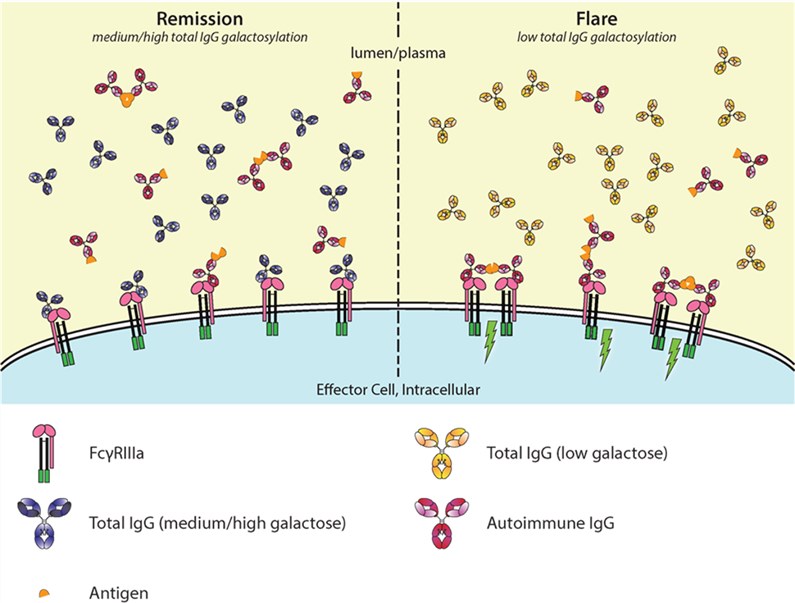Optimization of Galactosylation & Degree of Branching
As a long-term pioneer as well as a market leader in the field of therapeutic antibody development, Creative Biolabs has successfully established the Fc engineering services to optimize physicochemical properties and functions mediated by Fc fragment for the achievement of expected clinical results. Particularly, we offer optimization of galactosylation and degree of branching services for our customers globally.
Introduction to Galactosylation & Degree of Branching
For IgG antibodies, there is a conserved N-glycosylation site on the Fc domain to which a complex, biantennary glycan is attached. As one of the most common post-translational modifications (PTMs) of antibodies, it has shown a profound impact on the safety and efficacy of therapeutic proteins via modulating a wide range of antibody properties, such as immunogenicity, effector functions, and in vivo circulatory half-life. As antibody quality is becoming more critical and the type and level of glycosylation can significantly alter antibody binding, function, and therapeutic efficacy, glycosylation has been steadily gaining attention.
 Fig.1 Galactosylation of total IgG affects IgG-occupation of FcγRIIIa, affecting activation thresholds and flares in autoimmunity.1
Fig.1 Galactosylation of total IgG affects IgG-occupation of FcγRIIIa, affecting activation thresholds and flares in autoimmunity.1
The major Fc glycans of IgG therapeutic antibodies contain 0 or 1 or 2 (G0, G1, and G2, respectively) terminal galactose residues as non-reducing termini. Studies have reported that controlling of galactosylation level may have an effect on antibody effector functions. It has been proved that the presence of galactose can enhance the complement-dependent cytotoxic activity (CDC) of some antibodies due to the higher affinity to C1q. Studies have suggested that the non-covalent interactions between galactose and amino acid residues may account for the increased binding affinity between galactosylated Fc and C1q. Moreover, increased galactosylation of CHO-derived antibodies has been shown to increase FcγRII and FcγRIIIa binding as measured using surface plasmon resonance.
The degree of branching is a structural property that is determined by the concentration of linear (L), terminal (T) and dendritic (D) units within the polymer matrix. The branching degree also has an effect on the activity of the polysaccharide. Only when the polysaccharide reaches a certain degree of branching can it be biologically active. Moreover, glycoforms with distinct length, branching, and charge of sugar residues relate to the different susceptibilities of IgGs to proteolysis.
Optimization of Galactosylation and Degree of Branching
Due to the fact that galactose and branching levels can have an effect on antibody properties and effector functions, proper control of galactosylation and degree of branching to optimize antibody performance is warranted during manufacturing. Creative Biolabs has concentrated on glycoengineering of therapeutic antibodies (including Fc-fusion proteins) for years. With our combined knowledge and state-of-the-art facilities, we can customize the services to help produce antibodies with optimal galactosylation levels and degree of branching to maximize drug efficacy. This can be achieved by selecting different expression systems or optimizing culture media. Moreover, we can help to further study the relationship between glycosylation levels and antibody function/efficacy.
Features of Our Services
- Extensive experience
- Advanced biotechnologies
- Fully customizable experimental design to expand beyond standard procedure
- Competitive prices with the best quality
As a forward-looking company as well as a leading custom-specific service provider in the field of antibody function assays, Creative Biolabs has won a good reputation among our worldwide customers for successfully accomplishing numerous challenging projects. If you are interested in our services, please do not hesitate to contact us for more details.
Reference
-
Dekkers, Gillian, Theo Rispens, and Gestur Vidarsson. "Novel concepts of altered immunoglobulin G galactosylation in autoimmune diseases." Frontiers in Immunology 9 (2018): 335415.
Distributed under Open Access License CC BY 4.0, without modification.
For Research Use Only.
